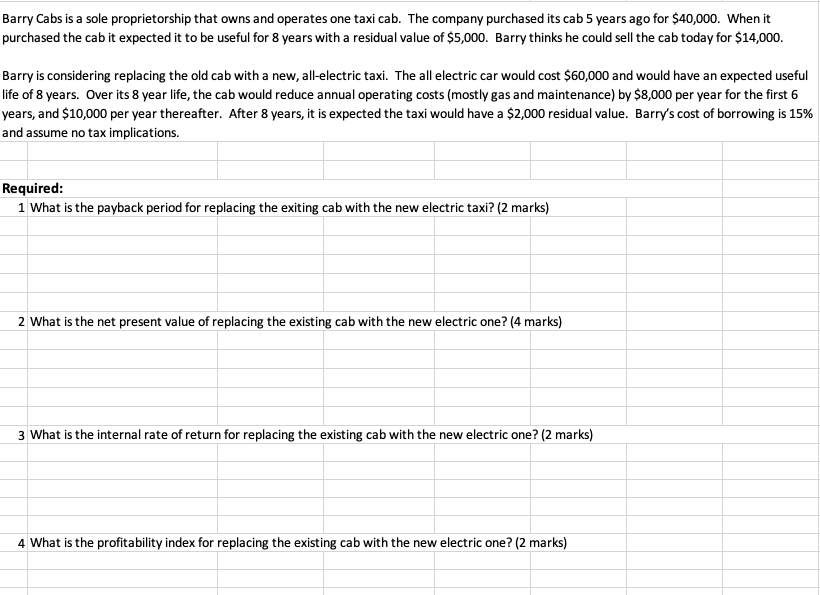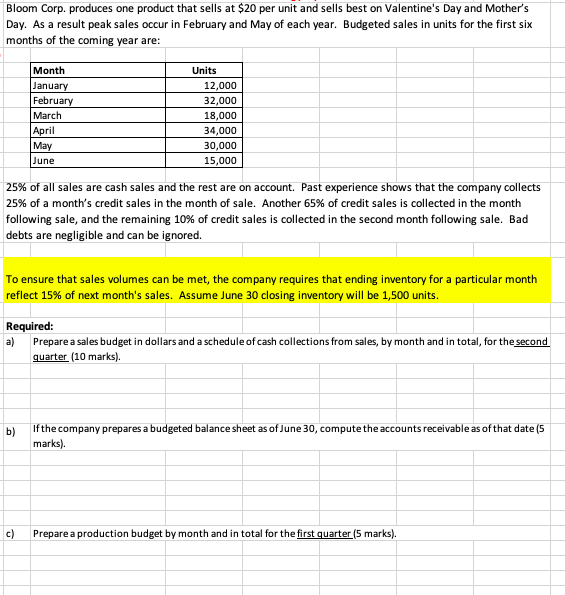Barry Cabs is a sole proprietorship that owns and operates one taxi cab. The company purchased its cab 5 years ago for $40,000. When it purchased the cab it expected it to be useful for 8 years with a residual value of $5,000. Barry thinks he could sell the cab today for $14,000. Barry is considering replacing the old cab with a new, all-electric taxi. The all electric car would cost $60,000 and would have an expected useful life of 8 years. Over its 8 year life, the cab would reduce annual operating costs (mostly gas and maintenance) by $8,000 per year for the first 6 years, and $10,000 per year thereafter. After 8 years, it is expected the taxi would have a $2,000 residual value. Barry's cost of borrowing is 15% and assume no tax implications.
Barry Cabs is a sole proprietorship that owns and operates one taxi cab. The company purchased its cab 5 years ago for $40,000. When it purchased the cab it expected it to be useful for 8 years with a residual value of $5,000. Barry thinks he could sell the cab today for $14,000. Barry is considering replacing the old cab with a new, all-electric taxi. The all electric car would cost $60,000 and would have an expected useful life of 8 years. Over its 8 year life, the cab would reduce annual operating costs (mostly gas and maintenance) by $8,000 per year for the first 6 years, and $10,000 per year thereafter. After 8 years, it is expected the taxi would have a $2,000 residual value. Barry's cost of borrowing is 15% and assume no tax implications.
Financial Accounting
14th Edition
ISBN:9781305088436
Author:Carl Warren, Jim Reeve, Jonathan Duchac
Publisher:Carl Warren, Jim Reeve, Jonathan Duchac
Chapter10: Fixed Assets And Intangible Assets
Section: Chapter Questions
Problem 3CP: Tuttle Construction Co. specializes in building replicas of historic houses. Tim Newman, president...
Related questions
Question
Looking for answers. I have attached images below. Thanks!

Transcribed Image Text:Barry Cabs is a sole proprietorship that owns and operates one taxi cab. The company purchased its cab 5 years ago for $40,000. When it
purchased the cab it expected it to be useful for 8 years with a residual value of $5,000. Barry thinks he could sell the cab today for $14,000.
Barry is considering replacing the old cab with a new, all-electric taxi. The all electric car would cost $60,000 and would have an expected useful
life of 8 years. Over its 8 year life, the cab would reduce annual operating costs (mostly gas and maintenance) by $8,000 per year for the first 6
years, and $10,000 per year thereafter. After 8 years, it is expected the taxi would have a $2,000 residual value. Barry's cost of borrowing is 15%
and assume no tax implications.
Required:
1 What is the payback period for replacing the exiting cab with the new electric taxi? (2 marks)
2 What is the net present value of replacing the existing cab with the new electric one? (4 marks)
3 What is the internal rate of return for replacing the existing cab with the new electric one? (2 marks)
4 What is the profitability index for replacing the existing cab with the new electric one? (2 marks)

Transcribed Image Text:Bloom Corp. produces one product that sells at $20 per unit and sells best on Valentine's Day and Mother's
Day. As a result peak sales occur in February and May of each year. Budgeted sales in units for the first six
months of the coming year are:
Month
January
Units
12,000
February
March
|Аpril
May
32,000
18,000
34,000
30,000
June
15,000
25% of all sales are cash sales and the rest are on account. Past experience shows that the company collects
25% of a month's credit sales in the month of sale. Another 65% of credit sales is collected in the month
following sale, and the remaining 10% of credit sales is collected in the second month following sale. Bad
debts are negligible and can be ignored.
To ensure that sales volumes can be met, the company requires that ending inventory for a particular month
reflect 15% of next month's sales. Assume June 30 closing inventory will be 1,500 units.
Required:
a)
Prepare a sales budget in dollars and a schedule of cash collections from sales, by month and in total, for the second
quarter (10 marks).
b)
If the company prepares a budgeted balance sheet as of June 30, compute the accounts receivable as of that date (5
marks).
c)
Prepare a production budget by month and in total for the first quarter (5 marks).
Expert Solution
This question has been solved!
Explore an expertly crafted, step-by-step solution for a thorough understanding of key concepts.
Step by step
Solved in 2 steps

Knowledge Booster
Learn more about
Need a deep-dive on the concept behind this application? Look no further. Learn more about this topic, accounting and related others by exploring similar questions and additional content below.Recommended textbooks for you

Financial Accounting
Accounting
ISBN:
9781305088436
Author:
Carl Warren, Jim Reeve, Jonathan Duchac
Publisher:
Cengage Learning



Financial Accounting
Accounting
ISBN:
9781305088436
Author:
Carl Warren, Jim Reeve, Jonathan Duchac
Publisher:
Cengage Learning




Individual Income Taxes
Accounting
ISBN:
9780357109731
Author:
Hoffman
Publisher:
CENGAGE LEARNING - CONSIGNMENT

EBK CONTEMPORARY FINANCIAL MANAGEMENT
Finance
ISBN:
9781337514835
Author:
MOYER
Publisher:
CENGAGE LEARNING - CONSIGNMENT